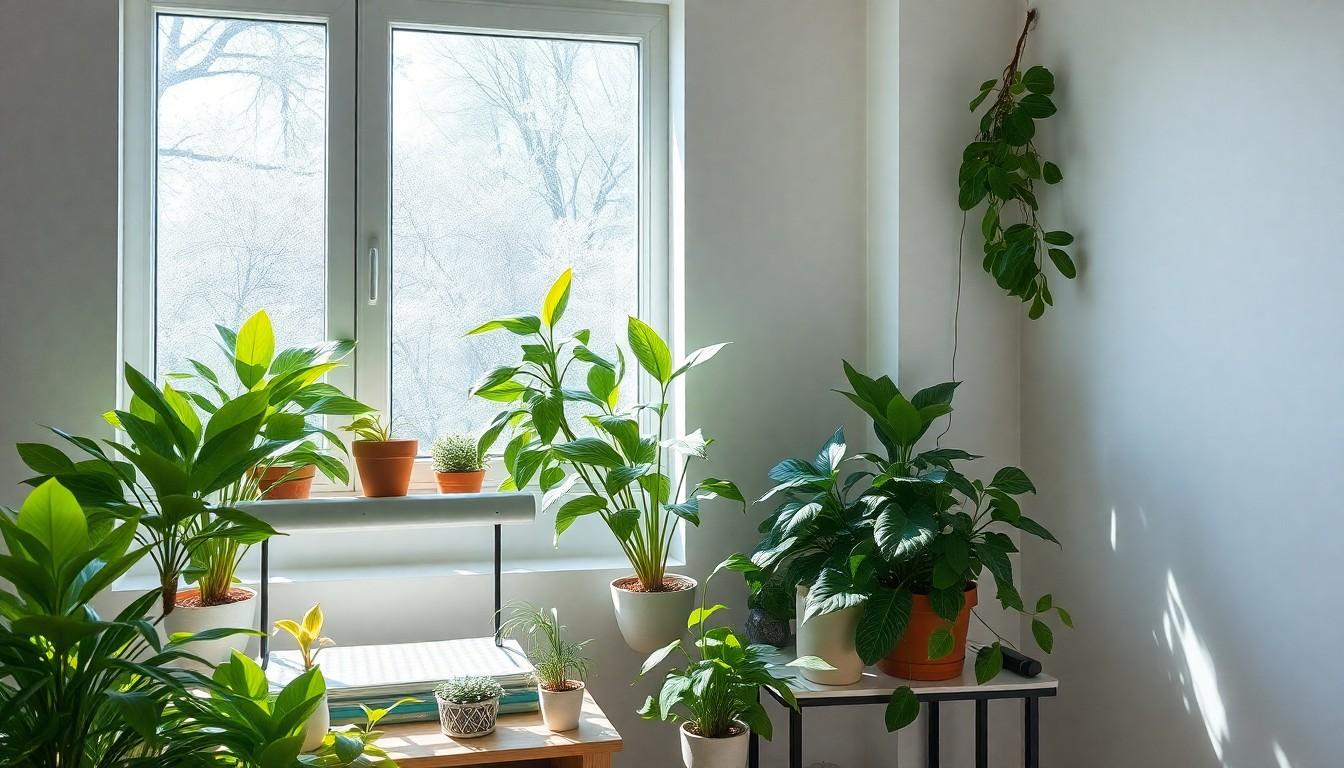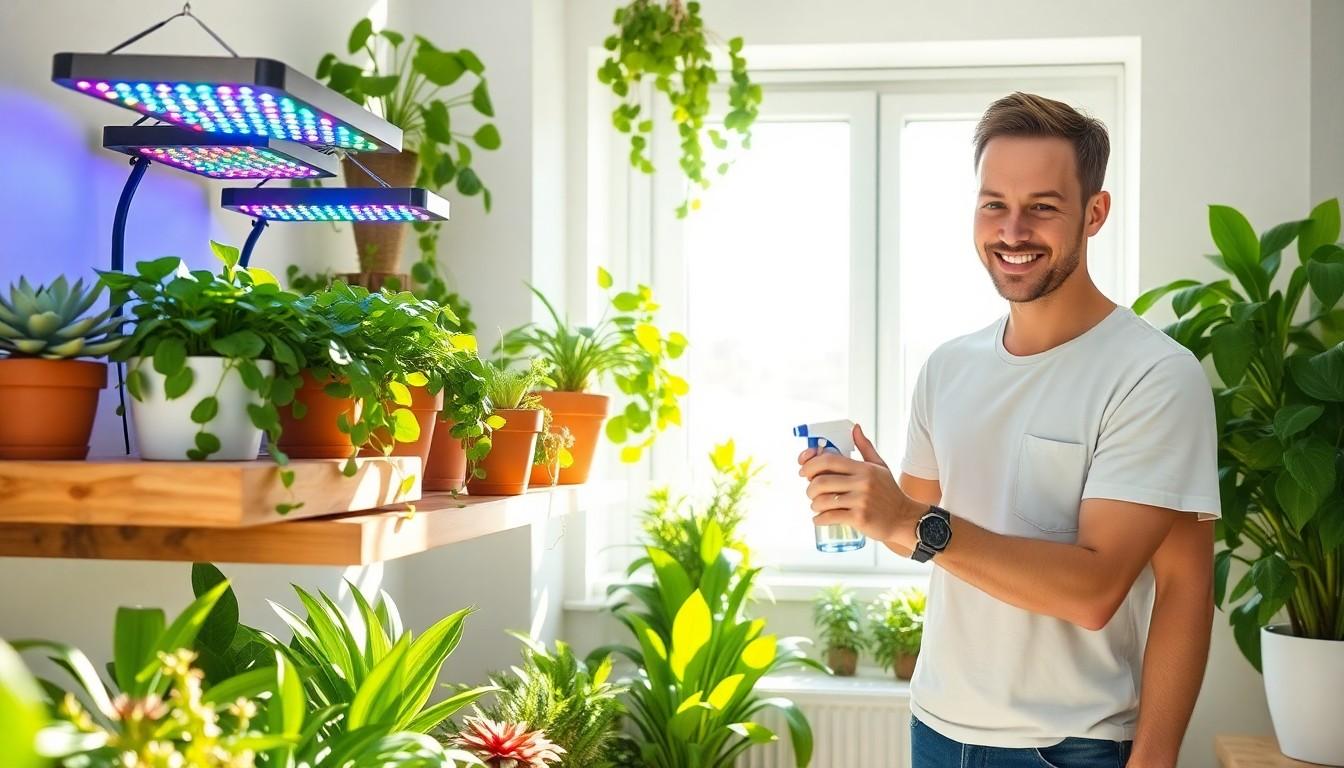Indoor plants are the ultimate green companions, but they’re not just looking for a cozy corner to hang out in. They crave the right lighting to thrive and show off their leafy glory. Imagine trying to read a book in a dim room—frustrating, right? Your plants feel the same way! Without the proper light, they can become droopy and sad, resembling a wilted salad rather than the vibrant decor they’re meant to be.
Understanding Lighting For Indoor Plants
Proper lighting plays a crucial role in the health of indoor plants. Every plant species has specific light requirements, making it essential to choose the right lighting conditions.
Importance Of Proper Lighting
Proper lighting serves as the foundation for photosynthesis. Without adequate light, plants struggle to produce energy, leading to poor growth and vitality. Vibrant foliage and healthy blooms rely on sufficient illumination. Insufficient light can cause stretching, weak stems, and yellowing leaves. Observing growth patterns helps identify lighting issues, allowing adjustments that promote thriving indoor greenery.
Types Of Light Used
Different types of light cater to various indoor plants. Natural light, coming through windows, varies in intensity based on orientation and time of day. Artificial lighting offers flexibility with options like fluorescent, LED, and incandescent bulbs. Each type emits distinct wavelengths, impacting plant growth. For instance, LED lights provide energy-efficient solutions that generate less heat and are ideal for specific growth stages. Understanding these light types enhances the ability to match plants with their optimal lighting conditions.
Natural Light Vs. Artificial Light

Plants thrive best with appropriate light sources, prompting a comparison between natural and artificial light options. Each type plays a significant role in plant health.
Benefits Of Natural Light
Natural light serves as the primary energy source for photosynthesis. Sunlight contains a full spectrum of wavelengths that support growth, promoting robust plant development. Plants receiving adequate natural light exhibit vibrant colors and healthier foliage. Direct sunlight can enhance flowering in certain species, boosting overall aesthetics. Cost-effectiveness also plays a role; natural light doesn’t incur any utility expenses. However, seasonal changes can affect its consistency, requiring careful management of light exposure.
Pros And Cons Of Artificial Light
Artificial light offers flexibility in placement and timing. Homeowners can choose specific light wavelengths to benefit various plant growth stages. LED lights generate less heat, reducing the risk of overheating plants while providing effective illumination. On the downside, energy consumption can lead to increased electricity costs. Some plants may not respond well to certain artificial light sources, leading to suboptimal growth. Additionally, artificial light may lack the full spectrum necessary for optimal photosynthesis, making it less effective than natural sunlight in certain scenarios.
Best Light Sources For Indoor Plants
Selecting the right light source ensures optimal growth conditions for indoor plants.
LED Grow Lights
LED grow lights provide energy-efficient illumination tailored to plant needs. These lights emit specific wavelengths supporting photosynthesis across various growth stages. Unlike conventional bulbs, LED options produce minimal heat, reducing potential plant stress. Many growers prefer full-spectrum LEDs to achieve better results. Longevity is another advantage, often exceeding 50,000 hours, which lowers replacement frequency. Adjustable intensity allows for customization based on plant species and proximity. Their versatility makes LEDs a popular choice among indoor gardening enthusiasts.
Fluorescent Lights
Fluorescent lights are an economical solution for illuminating indoor plants. They produce a wide spectrum and offer various color temperatures, accommodating different plant growth phases. T5 fluorescent bulbs, known for their efficiency, deliver higher lumens per watt compared to older versions. These lights emit less heat, minimizing the risk of overheating plants. Many users appreciate their ability to cover larger areas, making them suitable for multiple pots or trays. Gardeners often position them close to plants for maximum light penetration. With low energy consumption, fluorescent lights remain budget-friendly while supporting healthy plant development.
Tips For Positioning Plants
Proper plant positioning boosts growth. Finding the right spots in the home enhances light exposure. East-facing windows work best for morning sunlight. South-facing locations provide bright, indirect light throughout the day. West-facing windows support warmth during late afternoons. Avoid placing plants near cold drafts or heat sources, as these can stress them. Balancing light and temperature ensures a thriving indoor environment.
Optimal Locations In Your Home
Assess natural light availability in each room. Bright areas favor plants needing high light, such as succulents. Low-light plants, like snake plants or pothos, adapt well in dimmer spaces. Shelving can also create layered lighting effects, enhancing exposure. Consider revolving plants occasionally for even light distribution. Window sills often serve as ideal plant spots, allowing for direct sun access. Observing how light shifts throughout the day will help in deciding precise placements.
Adjusting Light Based On Plant Needs
Understand individual light requirements for each plant. Some plants flourish under full-spectrum light, while others thrive in partial shade. Use movable grow lights for plants needing additional support. Rotate plants every few weeks, ensuring all sides receive adequate light. When adjusting, consider seasonal changes that may impact natural light levels. Monitor the response of plants after repositioning to ensure they’re thriving. Address any signs of stress, such as yellowing leaves or leggy growth, by modifying their light exposure.
Conclusion
Proper lighting is essential for the health and vitality of indoor plants. By understanding the specific light needs of each plant species, gardeners can create





